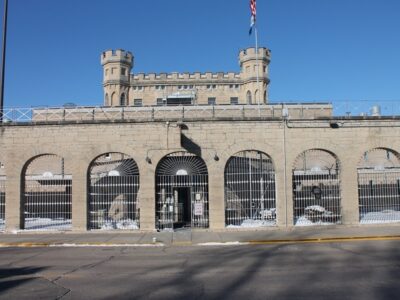
Criminal Justice and Rehabilitation in Wisconsin
Every U.S. state is tasked with constructing its criminal justice system. While such systems share many characteristics, no two systems are the same. The same factors make states unique; population, geographic size, cultural attitudes, political leanings, GDP, poverty rate, socioeconomic conditions, and other aspects will inevitably influence how a state constructs and manages its criminal justice system. This article seeks to briefly summarize the Wisconsin criminal justice system and its various facets.
Wisconsin’s Prison Population

The best way to understand a state’s approach to criminal justice is to determine how many people that state chooses to lock up. Other critical questions to find answers to include:
- What criminal rehabilitation programs are used in Wisconsin?
- Are there alternatives to incarceration in Wisconsin?
- How many people are incarcerated in Wisconsin?
- What are the biggest prisons in Wisconsin?
- What is Wisconsin’s recidivism rate?
- What is Wisconsin’s crime rate?
But of all the questions above, answering “How many people are incarcerated in Wisconsin?” gives one a clue as to how the state approaches crime.
According to the Bureau of Justice Statistics, Wisconsin has the 22nd highest incarceration rate in the country, just ahead of Tennessee but just behind Michigan. Wisconsin locks up about 318 people for every 100,000 living in the state. The overall incarceration rate in the U.S. is 350 per 100,000, slightly higher than the Wisconsin rate.1
But how many people are actually behind bars in Wisconsin? According to the National Institute of Corrections, Wisconsin operates 76 jails in 72 counties.2 The jail population in 2019 was 13,650. According to that source, Wisconsin operates 18 state prisons with 23,956 prisoners. The state also manages a community corrections program with 42,693 people under probation and 22,292 under parole. State-operated facilities in Wisconsin had a staff of 10,128 employees and a budget of $1,276,230,700. According to the Urban Institute, Wisconsin’s Department of Corrections is the 7th costliest item on the state’s annual budget.3

Waupun Correctional Institution. Image courtesy of doc.wi.gov
According to a 2019 report published by the Sentencing Project, Wisconsin used to contract with private prisons, but it no longer does.4 In 2000, 4,337 Wisconsin inmates were serving time in private prisons. By 2019, none were. Today, the largest prison in Wisconsin is the Waupun Correctional Institution. This prison for men is located in Waupun, Wisconsin, was opened in 1851, is managed by the Wisconsin Department of Corrections Division of Adult Institutions, and can accommodate up to 882 inmates.5
Wisconsin Crime Data
To understand a state’s criminal justice system, one must also study that state’s crime rate, as criminal justice systems exist to deter and punish crime and keep residents safe from those who would commit crimes. Further, crime rates act as a powerful indicator of whether or not a state’s criminal justice system is working. When crime rates spike, that indicates adjustments are needed in the state’s criminal justice methodology. When crime rates drop, the state is doing something right, and whatever led to the drop in crime should be continued.
According to Wisconsin’s Department of Justice:6
- Wisconsin homicides have more than doubled in the state, up 121% in 2022.
- Non-fatal shootings are also up in 2021, jumping from 444 to 877 (a 98% increase).
- Auto thefts increased 132% in 2022, with far more automobiles being stolen than in 2021.
- Reports of aggravated assaults (including shootings) rose 24% over 2021’s recorded figures.
- Last but not least, the crimes of larceny and theft are also on the rise, up 9% in 2022 over 2021’s figures.
The above is just a brief look at crime rates in Wisconsin. But it shows how, despite years of progress in tackling Wisconsin’s crime rate (most crime in Wisconsin steadily declined from 2006 to 2020), both violent and property crime are now on the rise.
Wisconsin Recidivism
Another crucial metric to examine when studying a state’s criminal justice system is its recidivism rate. Recidivism is the rate at which formerly incarcerated persons commit new crimes, are caught, and are returned to incarceration. The higher a state’s recidivism rate, the more needs to be done to improve the state’s educational and rehabilitation programs inside prisons. According to its Department of Corrections, Wisconsin’s recidivism rate has hovered between 40% and 50% since 2000, with recent upticks in rearrest, re-incarceration, and re-conviction.7
Though there are states in the U.S. with higher recidivism rates, it is not good that nearly half of all inmates who go through Wisconsin’s prison system re-offend and become reincarcerated within three years of their release. That means more work needs to be done to improve the rehabilitative services offered to inmates in Wisconsin.
Criminal Reform and Alternatives to Incarceration in Wisconsin

For incarcerated individuals, Wisconsin inmates have some access to rehabilitative programs, but more is needed. Critically, Wisconsin should work to implement key programs like the following in every prison and jail in the state:
- Drug and alcohol rehabilitation services for those serving time for drug offenses
- Vocational programs for those who need training for gainful employment once released
- Life skills training and coping strategies so inmates can get down to the bottom of why they committed crimes
Further, many people who go to prison in Wisconsin should not necessarily be there. For example, alternatives to incarceration would be a great way to prevent low-level and nonviolent offenders from ever moving through the incarceration system, which benefits them and Wisconsin taxpayers. Some of the alternatives to incarceration currently offered in Wisconsin include:8
- Day Reporting Center
- Home Detention Program
- Intensive Supervision Program
- Employment Services Program
- Pre-Trial Risk Assessment Program
- Children First Employment Program (CF)
- Community Service Program & Inmate Worker Program
- AODA In-Jail and aftercare programs for adults (drug rehab programs)
Finally, the Badger State must also implement educational programs inside prisons in Wisconsin. Educational programs can help Wisconsin lawbreakers learn more about themselves and why they committed crimes. Educational programs can help teach inmates how to live meaningful lives. When Wisconsin offenders are empowered with tools and a better understanding of how to live life as responsible adults, they’re less likely to re-offend.
Sources:
- BJS. “Prisoners in 2020 – Statistical Tables.” Bureau of Justice Statistics, 2020. bjs.ojp.gov
- NIC. “Wisconsin 2019.” National Institute of Corrections, 2019. nicic.gov
- UI. “Project Wisconsin.” Urban Institute, 2023. urban.org
- TSP. “Private Prisons in the United States.” The Sentencing Project, 2019. sentencingproject.org
- WDOC. “Waupun Correctional Institution.” Wisconsin Department of Corrections, 2023. doc.wi.gov
- WDOJ. “Universal Crime Reporting Arrest Data.” Wisconsin Department of Justice, 2023. doj.state.wi.us
- WDOC. “Recidivism.” Wisconsin Department of Corrections, 2023. doc.wi.gov
- RCW. “Alternatives and Diversion Programs.” Racine County, Wisconsin, 2023. racinecounty.com
Related Articles
Minnesota Just Became the 28th State to Abolish Life-Without-Parole Sentences for Children
In May of 2023, Minnesota became the latest state to abolish life-without-parole sentences for juvenile offenders, the 28th state to enact criminal justice reform laws...
Read more >>
Michigan’s Unique Approach to Solving Ongoing Criminal Justice Problems
According to the National Institute of Corrections, Michigan’s 2019 jail population was 17,020, and its prison population was 38,053.1 Michigan has the 21st-highest incarceration rate...
Read more >>
Gainful Employment a Critical Factor in Post-Incarceration Life
Recidivism is one of the most important aspects of the United States criminal justice system and easily the most studied metric. The National Institute of...
Read more >>
Criminon of Maine Helps Inmates Take New Steps
"The “Conditions of Life” course was very useful. For the most part, this course helped to make me aware of 'current status' in conditions of...
Read more >>





